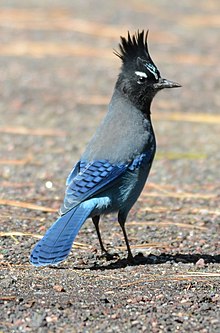Steller's jay
| Steller's jay | |
|---|---|
 |
|
| In Arizona, United States | |
| Scientific classification | |
| Kingdom: | Animalia |
| Phylum: | Chordata |
| Class: | Aves |
| Order: | Passeriformes |
| Family: | Corvidae |
| Genus: | Cyanocitta |
| Species: | C. stelleri |
| Binomial name | |
|
Cyanocitta stelleri (Gmelin, 1788) |
|
The Steller's jay (Cyanocitta stelleri) is a jay native to western North America, closely related to the blue jay found in the rest of the continent, but with a black head and upper body. It is also known as the long-crested jay, mountain jay, and pine jay. It is the only crested jay west of the Rocky Mountains. While it does not have as prominent a crest as the Blue Jay (Cyanocitta cristata) it can be found west of the Rockies especially in south east British Columbia.
The Steller's jay shows a great deal of regional variation throughout its range. Blackish-brown-headed birds from the north gradually become bluer-headed farther south. The Steller's jay has a more slender bill and longer legs than the blue jay and has a much more pronounced crest. It is also somewhat larger. The head is blackish-brown with light blue streaks on the forehead. This dark coloring gives way from the shoulders and lower breast to silvery blue. The primaries and tail are a rich blue with darker barring.
It occurs in coniferous forest over much of the western half of North America from Alaska in the north to northern Nicaragua completely replacing the blue jay in most of those areas. Some hybridization with the blue jay in Colorado has been reported. The Steller's jay lives in coniferous and mixed woodland, but not in completely dense forest, and requires open space. It typically lives in flocks of greater than 10 individuals. In autumn, flocks often visit oak woods when acorns are ripe.
The Steller's jay primarily lives in coniferous forests but can be found in many forested areas. They can be found in low to moderate elevations as high as the tree line, but rarely go that high. Steller's jays are common in residential and agricultural areas with nearby forests.
Steller's jays are omnivores; their diet is about two-thirds plant matter and one third animal matter. Food is gathered from both the ground and from trees. The Steller's jay's diet consists of a wide range of seeds, nuts, berries and other fruit. Many types of invertebrates, small rodents, eggs and nestlings such as those of the marbled murrelet are also eaten. There are some accounts of them eating small reptiles, both snakes and lizards. Acorns and conifer seeds are staples during the non-breeding season; these are often cached in the ground or in trees for later consumption. They exploit human-provided food sources, frequently scavenging picnics and camp sites. Steller's jays will visit feeders and prefer black-oil sunflower seeds, white striped sunflower seeds, cracked corn, shelled raw peanuts and are especially attracted to whole raw peanuts. Suet is also consumed but mostly in the winter season.
...
Wikipedia

